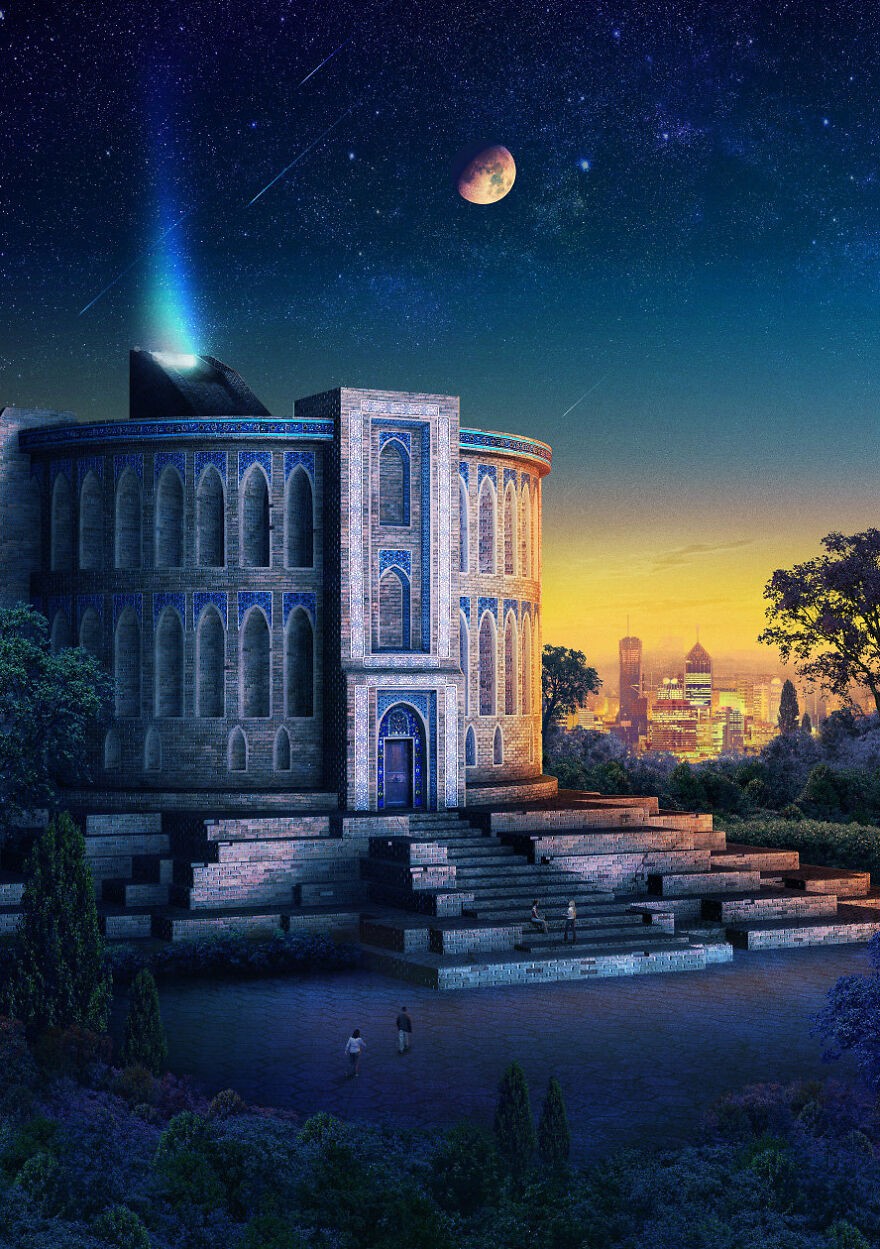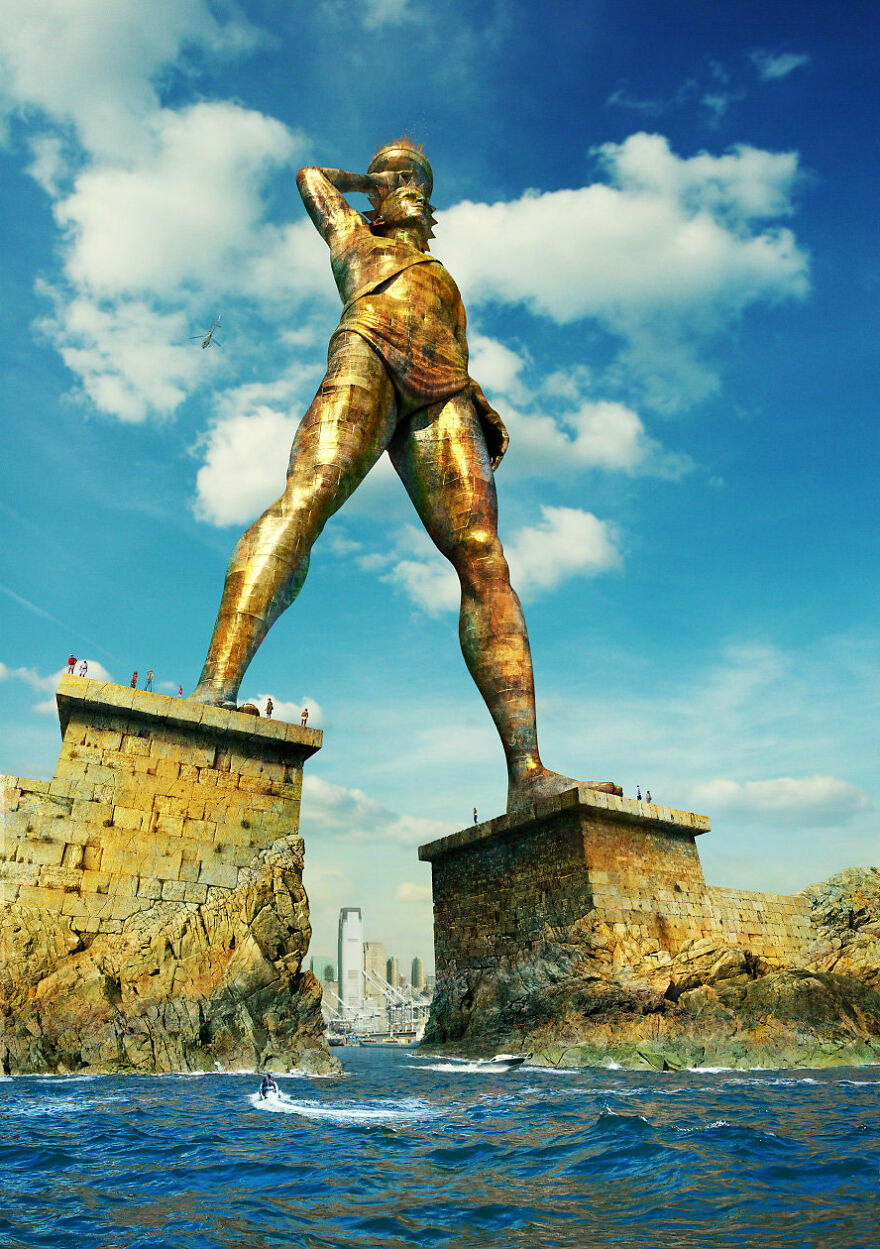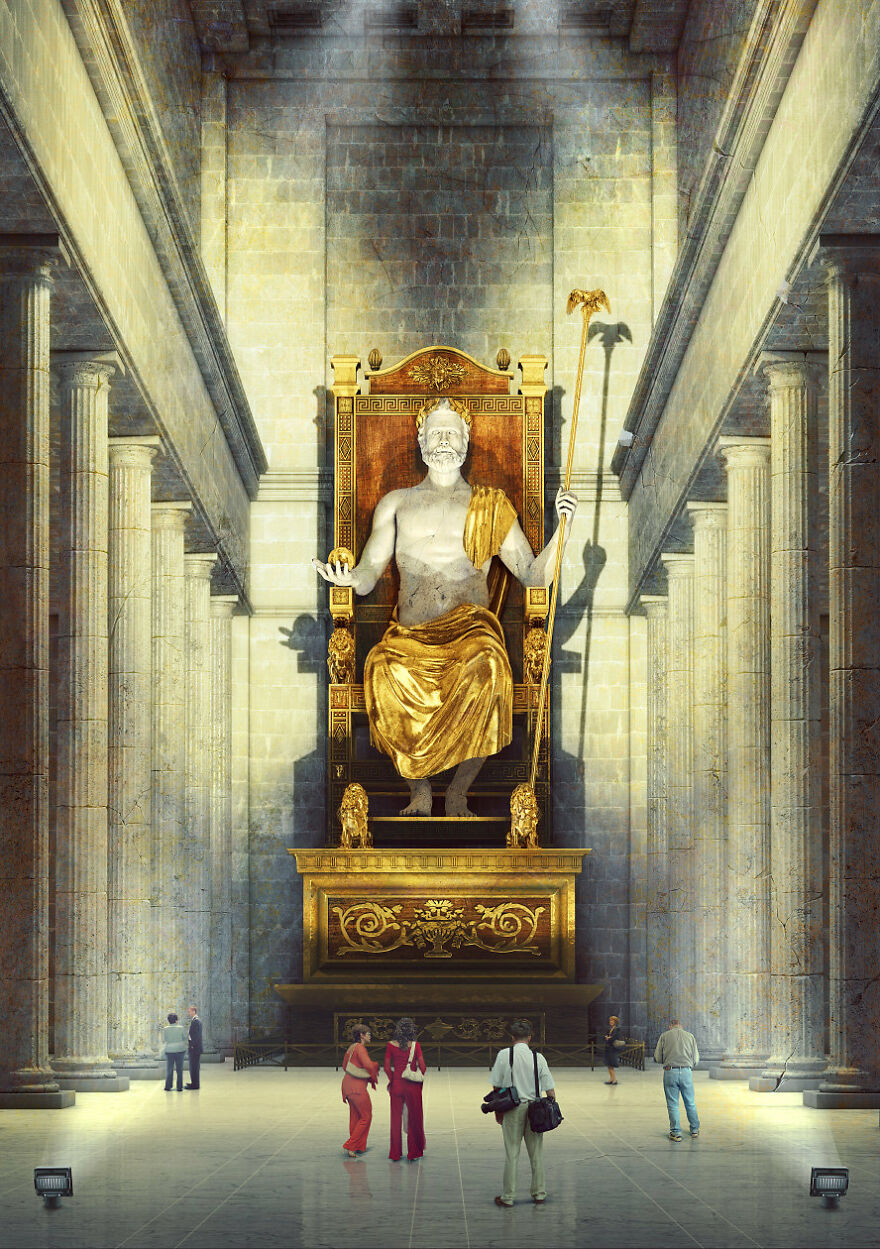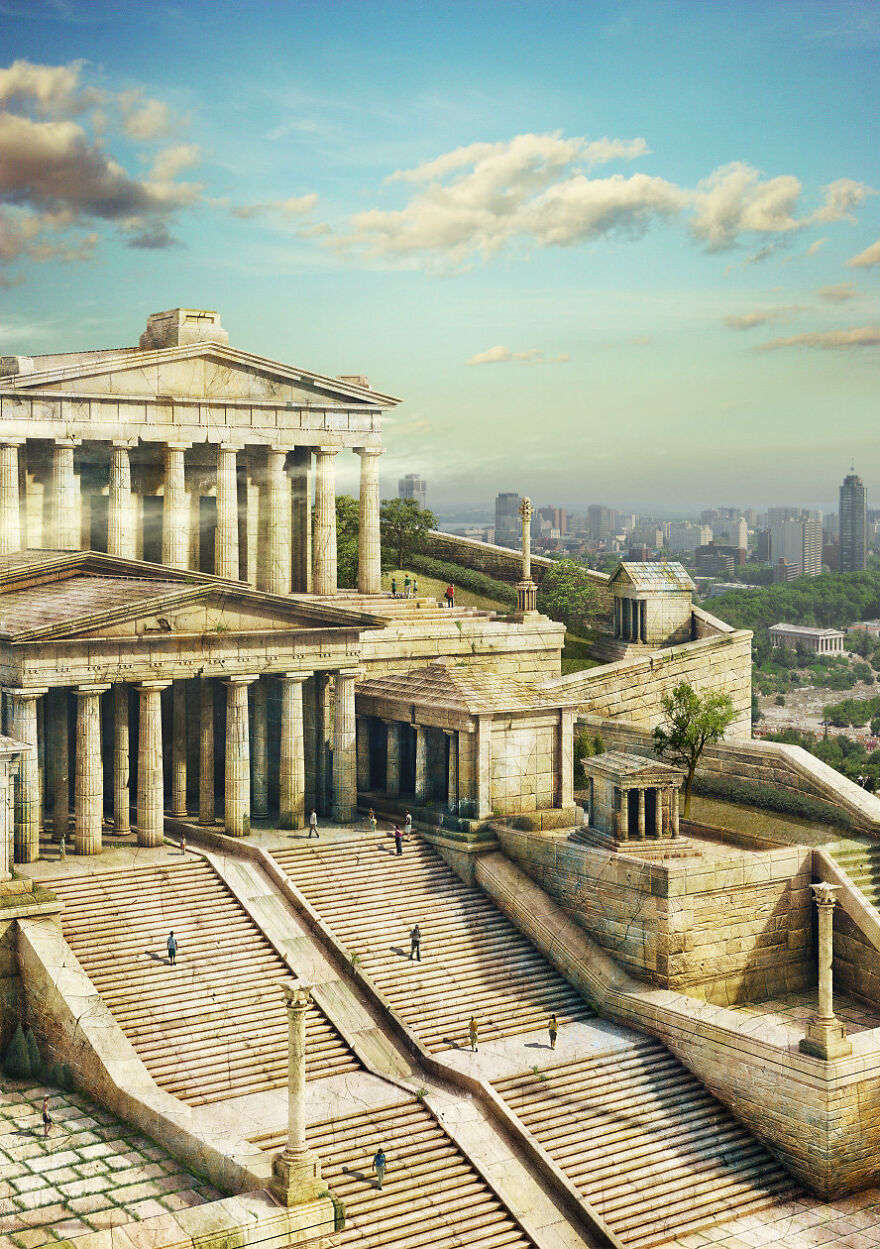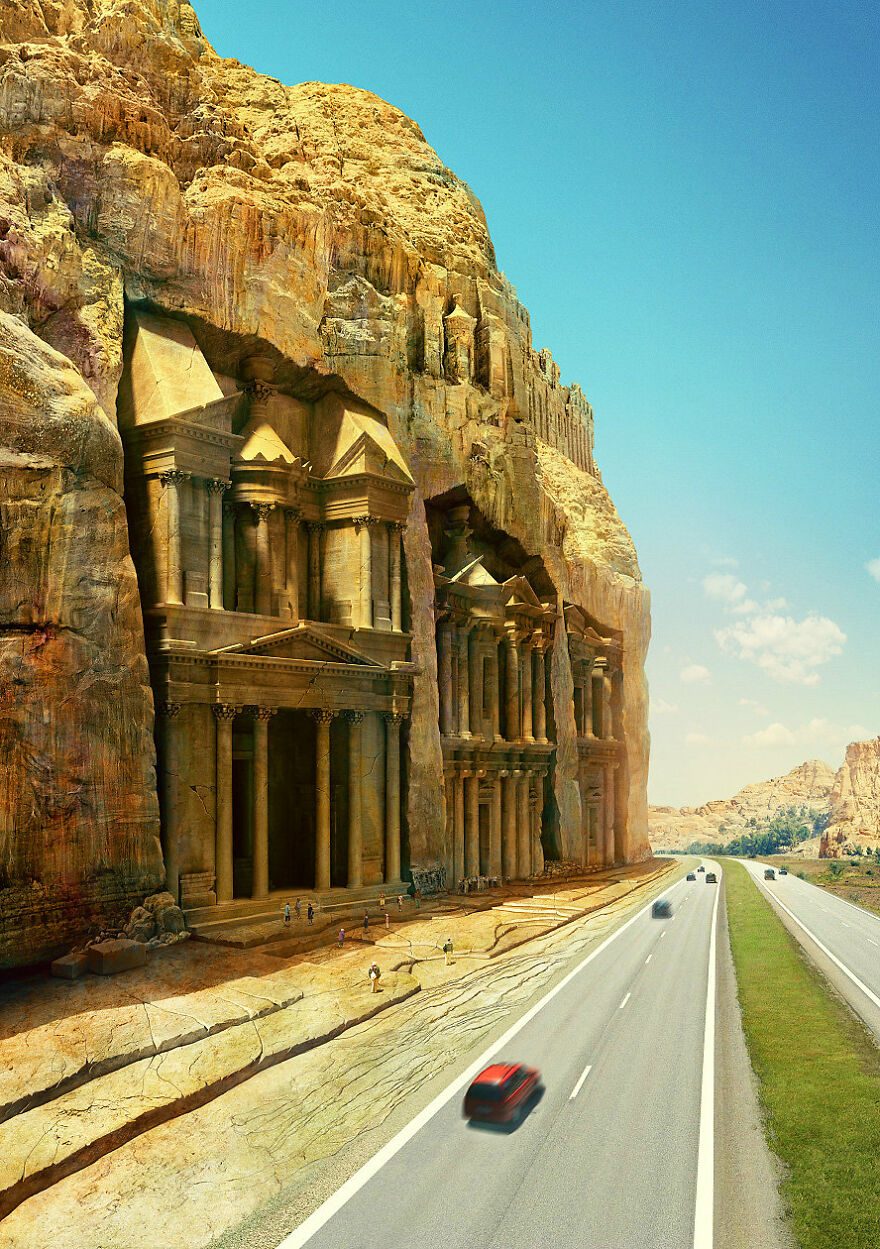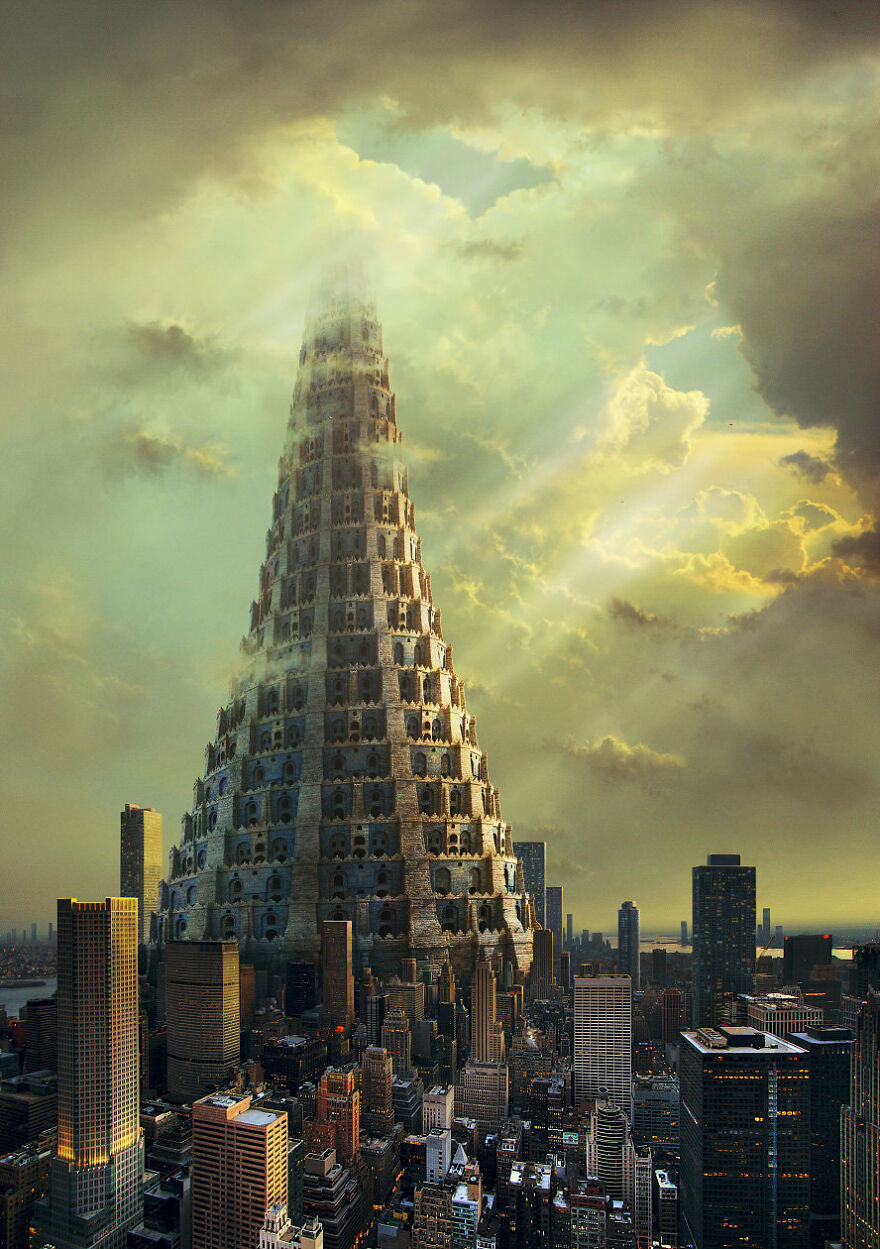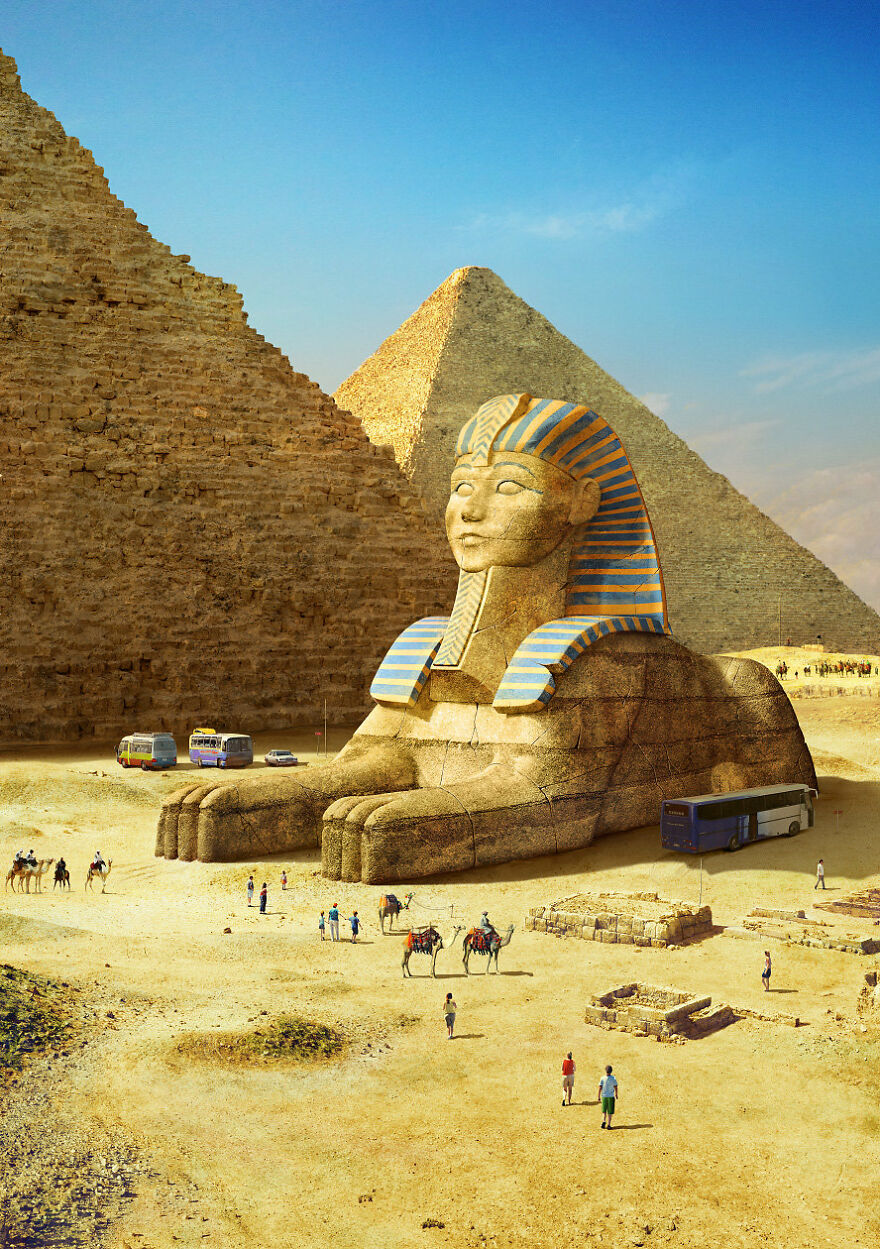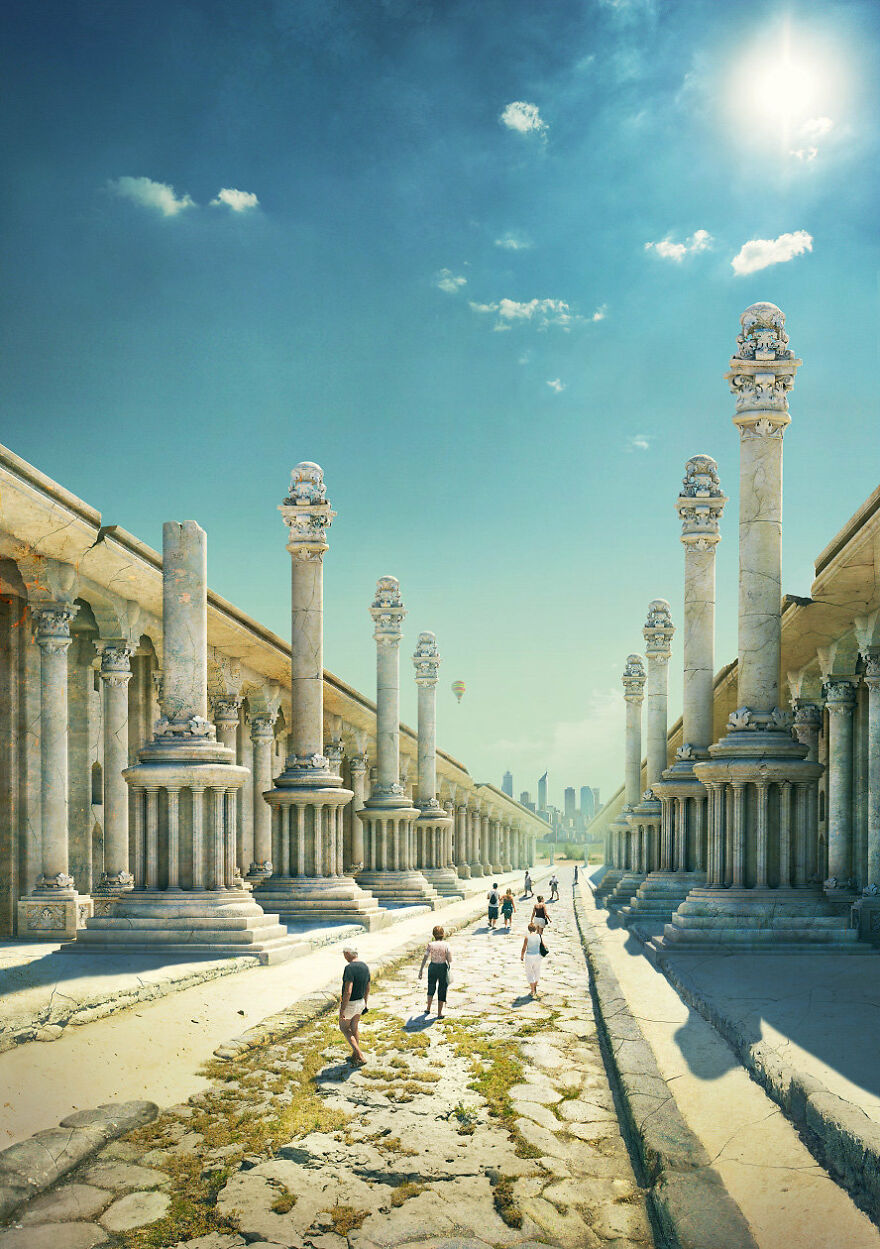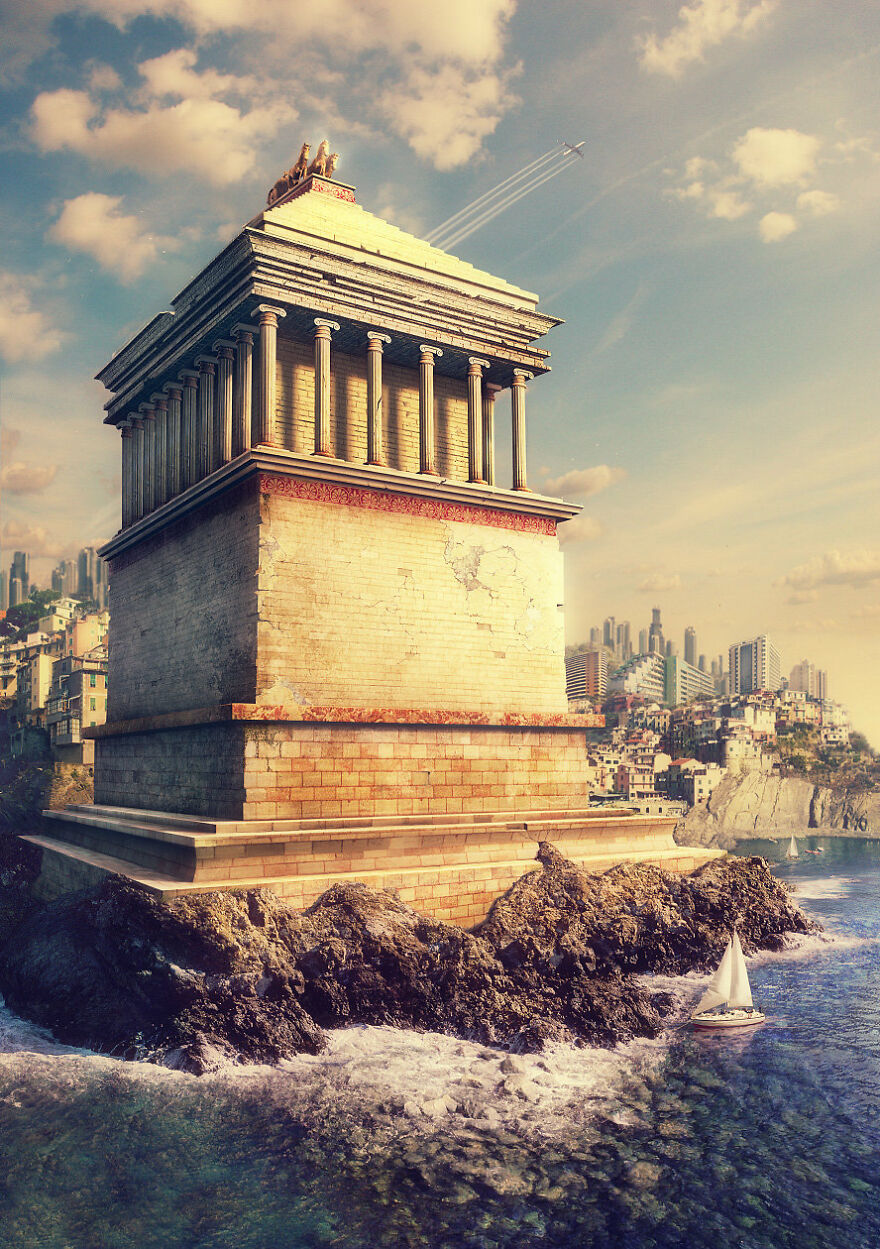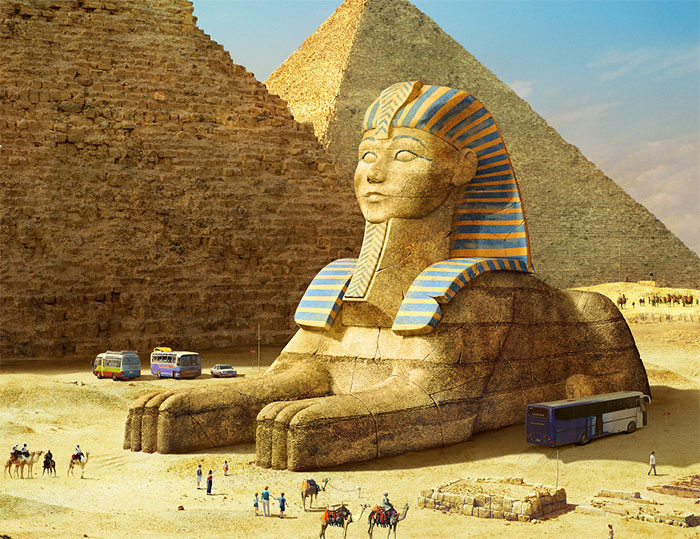
150Kviews
Artist Shows What These 10 Famous Historical And Mythical Monuments Would Look Like In Present Day If They Survived
One of the most interesting things about studying history is learning about the marvelous things that our ancestors created. But it can be frustrating not to be able to see them. One picture is worth a thousand words, as they say; and while there have been many things written about these awesome historical monuments, not everyone can imagine how they actually would've looked. But some artists actually put in the effort to recreate history in image form, and not only that, they bring this long-lost past into the present and try to imagine what it would look like if it had survived to this day.
Digital artist and graphic designer Evgeny Kazantsev was tasked to create an insurance commercial. He decided to give a glimpse at an alternate universe where the ancient wonders of the world and other fantastic structures survived, as if to say "this could've survived, if they only knew about insurance." Evgeny delivered and recreated these structures with a present-day background. The project was a success, and the result transcended the commercial medium and could be valued on artistic merits as well.
More info: Facebook | Instagram | behance.net | Instagram | Instagram
This post may include affiliate links.
The Hanging Gardens Of Babylon
The Hanging Gardens of Babylon were one of the Seven Wonders of the Ancient World. It's the only one of the Seven Wonders without a definitively established location. According to one legend, the Gardens were built alongside the palace known as The Marvel of Mankind by the king Nebuchadnezzar II (c. 605 and 562 BC) for his Median wife Queen Amytis, who missed the green hills of her home. The gardens are described as an example of ingenuity, engineering and beauty that looked like a tiered green hill with many terraces, hosting many plants, like shrubs, trees, and flowers.
It's funny really, it's the only wonder that there is no evidence that it existed at all. Many historians believe it never existed, some saying it was another Atlantis (a result of poetic imagination). There is no records of Nebuchadnezzar's wives and the many records of his constructions never once mention a garden. Ancient historians that have written of their time in Babylon never describe it. One theory is that the gardens were in fact elsewhere, many years earlier, but attributed to Nebuchadnezzar to increase his legend.
Agreed. Most likely they were in Nineveh, but Babylon was more famous so ascribed there. There is historical support for gardens in Nineveh.
Load More Replies...The Gardens may themselves have been fictional. We're just not sure...
Highly unrealistic, where are all the people taking selfie’s for Instagram?
Archeologists aren't even truly sure they existed. I hope they did, but it doesn't look good.
Looking at actual archaeological evidence they may have been at Nineveh instead of Babylon (who knows where the 'Babylon' part came from when the Greeks recorded the wonders of the world) where there is evidence of extensive aqueducts and gardens, and fits nicely with the recorded tradition of Assyrian palace gardening.
Load More Replies...I think it's a shame that this type of architecture has not survived to this day. It would be much nicer if new houses looked like this too.
Takkyubin Observatory Of Constantinople
Built by Taqi ad-Din Muhammad ibn Ma'ruf in 1577, the Constantinople observatory of Takkyubin (Taqi ad-Din) was one of the largest astronomical observatories in medieval world. However, its glory wasn't meant to last and it was destroyed in 1580, just three years after it had been built, because it wasn't just used for astronomy, but for astrology as well, a form of divination which is outlawed by the Sharia.
The Colossus Of Rhodes
The Colossus of Rhodes was a statue built to commemorate the successful defense of Rhodes city against a year-long siege by Demetrius Poliocretes. Standing approximately 108 feet tall, the tallest ancient statue is considered to be one of the original Seven Wonders of the Ancient World. However, it didn't stand for long: build by Chares of Lindos in 280BC, the colossus lasted only 54 years and collapsed during the earthquake of 226 BC. In accordance with a certain oracle, the Rhodians did not build it again. In the 21st century, there were proposals to build a new Colossus at Rhodes Harbor, and in 2015, some architects proposed a promising project, though some scholars criticize the location, claiming that it couldn't have been the original spot.
The Statue Of Zeus At Olympia
The Statue of Zeus at Olympia was a giant seated figure of Zeus, the king of the gods of Mount Olympus, that was about 41 ft tall, made by Greek sculptor Phidias around 435 BC at Olympia, Greece. The statue was commissioned by the Eleans, the hosts of the Olympic games, who wanted to rival the Athenian culture. The framework of the statue was wooden, and it was decorated with ivory and gold plates.
12 meters apparently, for anyone else wondering how much the hell 41 ft are.
The Acropolis Of Athens
The Acropolis of Athens is an ancient citadel built on a rocky hill overlooking the city of Athens. The Athenian Acropolis is a giant ensemble of buildings, with the Parthenon being the famous one. To this day, only several significant ancient buildings remain of the citadel. Pericles, a famous historical figure, coordinated the construction of the buildings that are considered to be the most important ones, like the Parthenon, the Propylaea, the Erechteion and the Temple of Athena Nike. The Parthenon and the other buildings were seriously damaged during the 1687 siege by the Venetians, as they hit the gunpowder storage at the Parthenon with a cannonball and it exploded.
The Great Temple At Petra
The Great Temple at Petra was a colossal complex finished in around the first century CE, under the rule of Nabatean king Aretas IV. It's not clear whether the building was designed for religious or for administrative purposes, and if it was religious, it remains unclear to what kind of deity it had been built. The vast ensemble of buildings occupies around 81,375 square feet and is well preserved compared to the other monuments on this list.
The Tower Of Babel
The Tower of Babel is a mythical structure mentioned in the book of Genesis in the Old Testament. It's an origin myth meant to explain why people speak different languages. While the Tower of Babel is considered by many to be a fictional structure, some scholars associate it with known structures in Babylon and Sumeria.
There actually is a ruins in Iraq that from carbon dating and location, would be the structure. This huge structure is described in many ancient accounts, including Herodotus, as well as non-biblical religous accounts including writings of the Priests of Marduk and ancient Sumerian legends. At at some point the tower ruins were stripped for building materials. Different estimates to its size have been suggested, some from 90 feet tall to 250 feet tall. We know a Temple was built on top at a later date, but that there were two structures, both which were destroyed.
The Great Sphinx Of Giza
The Great Sphinx of Giza is speculated to have been built by the Egyptians of the Old Kingdom during the reign of Khafre (c. 2558–2532 BC), whose face it appears to represent. It's made of limestone and was cut from the bedrock. Measured at 240 ft long from paw to tail, and 66 ft high, it's the oldest known monumental sculpture in Egypt, and one of the most well-recognized statues throughout the globe.
The Temple Of Artemis
The Artemision, or the Temple of Artemis, as it is more widely known, was dedicated to Artemis (Roman equivalent was Diana), the Greek goddess of the hunt, wilderness, wild animals, the Moon and chastity, a sister of Apollo. Located in Ephesus, the temple was completely rebuilt twice, once after a flood and another after an arson. By 401 AD it had been completely destroyed, and only the fragments and foundations of the last temple remain.
The earliest version of the temple dates back to the Bronze Age, while the construction of the final version of the Temple began around 550 BC and took approximately 10 years to complete.
This looks a bit knackered - broken rooofs, overgrown pathway. I thought the point of the artwork / article is to make them look new.
The Mausoleum At Halicarnassus
Built between 353 and 350 BC, the Mausoleum at Halicarnassus was the tomb for the Anatolian ruler of Caria, Mausolus, and his wife, Artemisia II. The structure was around 148 ft in height, and each of its sides was decorated with sculptural reliefs created by prominent Greek sculptors. Though the word mausoleum originally refers to the tomb of Mausolus, the word itself became associated with any kind of above-ground tomb.
It would have been interesting to see a pic of how these actually look today alongside the digital re-creation. Well, except for the Tower of Babylon since there's debate about whether it actually existed.
There's nothing left of the Colossus of Rhodes, Statue of Zeus, Hanging Gardens, Mausoleum At Halicarnassus and Takkyubin Observatory.
Load More Replies...Somewhat dismayed by the lack of Alexandria's lighthouse and library, or the great fortress of Alamut, for that matter!
I think the Sphinx was originally Sekhmet - "The Protector of the Pharaohs". One time Ra sent Sekhmet, to destroy the mortals who conspired against him. But Sekhmet's blood-lust was not quelled at the end of battle and led to her destroying almost all of humanity and then drinking their blood. To stop her, Ra poured out beer dyed with red ochre or hematite so that it resembled blood. Mistaking the beer for blood, she became so drunk that she gave up the slaughter and returned peacefully to Ra. The temple at Luxor has a "porch of drunkenness" built onto the temple by the Pharaoh Hatshepsut to celebrate Sekhmet stopping the slaughter. And each year after that they had a great festival celebrating the end of the slaughter. Historical records exist that report tens of thousands attended these festivals. To that I say, "Party on Wayne...Party on Garth". Sphinx-as-...41857e.jpg 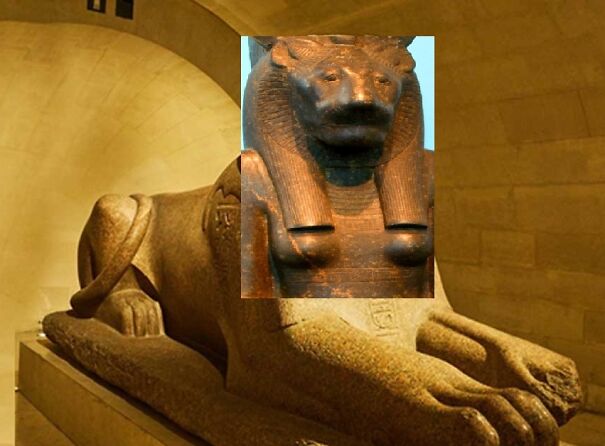
And apparently all of these monuments are located in a city with skyscrapers and highways?
Built on the blood of innumerable slaves. That is something history never mentions. World history is replete with war and violence. We don't need such things built now. Rather direct the money to more important requirements.
i was imaging if i could actually see one of these, which one would it be?
I wonder every time why the ruins are not rebuilt and restored, so that they are completed again. With Greece, I know that they have little money, so the Acropolis can not be rebuilt, but other countries could do it.
Why? All that would do is destroy what's left of the original ruins. These structures also serve no purpose anymore except as records of the past, so I don't see why you'd destroy what's left to build something that has no application to modern life. We also can't preserve every building ever built, however significant it was in its time. We already take up enough of the planet and have more than enough empty, decaying buildings.
Load More Replies...So a good majority of these objects or places still exist to this day many of them have been destroyed the Tower of Babble never existed and neither does God but that's a different story for you all. As for the fact that they are trying to add a more modern look to some of these locations it's kind of offensive and a lot of ways because they destroy its actual true beauty and value and I don't know how smart a lot of you are to believe that like the Great Sphinx has been destroyed or that just because Petra is abandoned that there could be a a road of any kind it was carved into a cliff face Petra means stone rock in Greek. You people are so blind to the true beauty of most of these places.
It would have been interesting to see a pic of how these actually look today alongside the digital re-creation. Well, except for the Tower of Babylon since there's debate about whether it actually existed.
There's nothing left of the Colossus of Rhodes, Statue of Zeus, Hanging Gardens, Mausoleum At Halicarnassus and Takkyubin Observatory.
Load More Replies...Somewhat dismayed by the lack of Alexandria's lighthouse and library, or the great fortress of Alamut, for that matter!
I think the Sphinx was originally Sekhmet - "The Protector of the Pharaohs". One time Ra sent Sekhmet, to destroy the mortals who conspired against him. But Sekhmet's blood-lust was not quelled at the end of battle and led to her destroying almost all of humanity and then drinking their blood. To stop her, Ra poured out beer dyed with red ochre or hematite so that it resembled blood. Mistaking the beer for blood, she became so drunk that she gave up the slaughter and returned peacefully to Ra. The temple at Luxor has a "porch of drunkenness" built onto the temple by the Pharaoh Hatshepsut to celebrate Sekhmet stopping the slaughter. And each year after that they had a great festival celebrating the end of the slaughter. Historical records exist that report tens of thousands attended these festivals. To that I say, "Party on Wayne...Party on Garth". Sphinx-as-...41857e.jpg 
And apparently all of these monuments are located in a city with skyscrapers and highways?
Built on the blood of innumerable slaves. That is something history never mentions. World history is replete with war and violence. We don't need such things built now. Rather direct the money to more important requirements.
i was imaging if i could actually see one of these, which one would it be?
I wonder every time why the ruins are not rebuilt and restored, so that they are completed again. With Greece, I know that they have little money, so the Acropolis can not be rebuilt, but other countries could do it.
Why? All that would do is destroy what's left of the original ruins. These structures also serve no purpose anymore except as records of the past, so I don't see why you'd destroy what's left to build something that has no application to modern life. We also can't preserve every building ever built, however significant it was in its time. We already take up enough of the planet and have more than enough empty, decaying buildings.
Load More Replies...So a good majority of these objects or places still exist to this day many of them have been destroyed the Tower of Babble never existed and neither does God but that's a different story for you all. As for the fact that they are trying to add a more modern look to some of these locations it's kind of offensive and a lot of ways because they destroy its actual true beauty and value and I don't know how smart a lot of you are to believe that like the Great Sphinx has been destroyed or that just because Petra is abandoned that there could be a a road of any kind it was carved into a cliff face Petra means stone rock in Greek. You people are so blind to the true beauty of most of these places.


